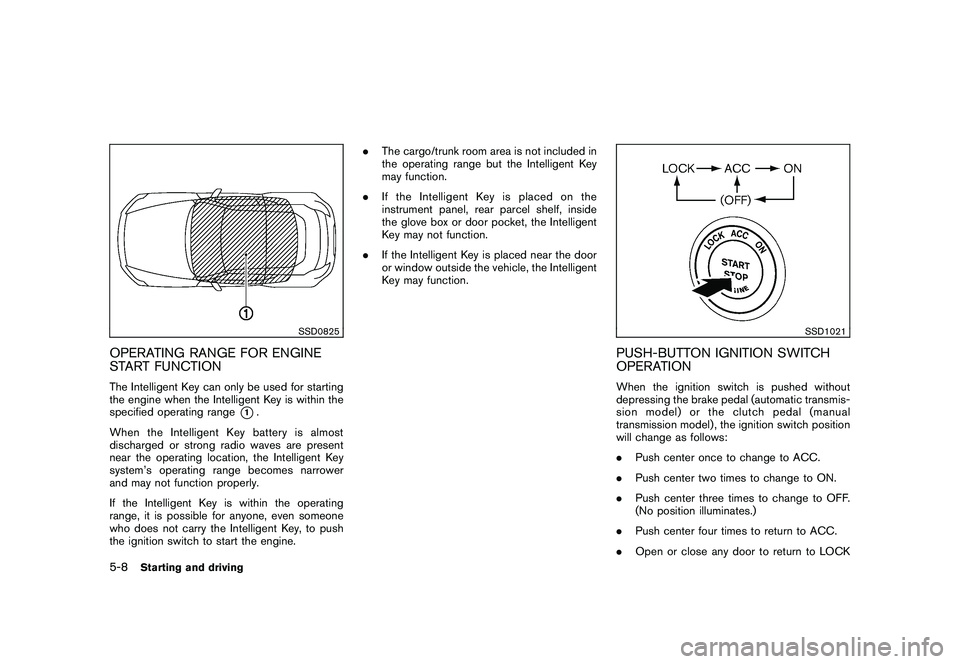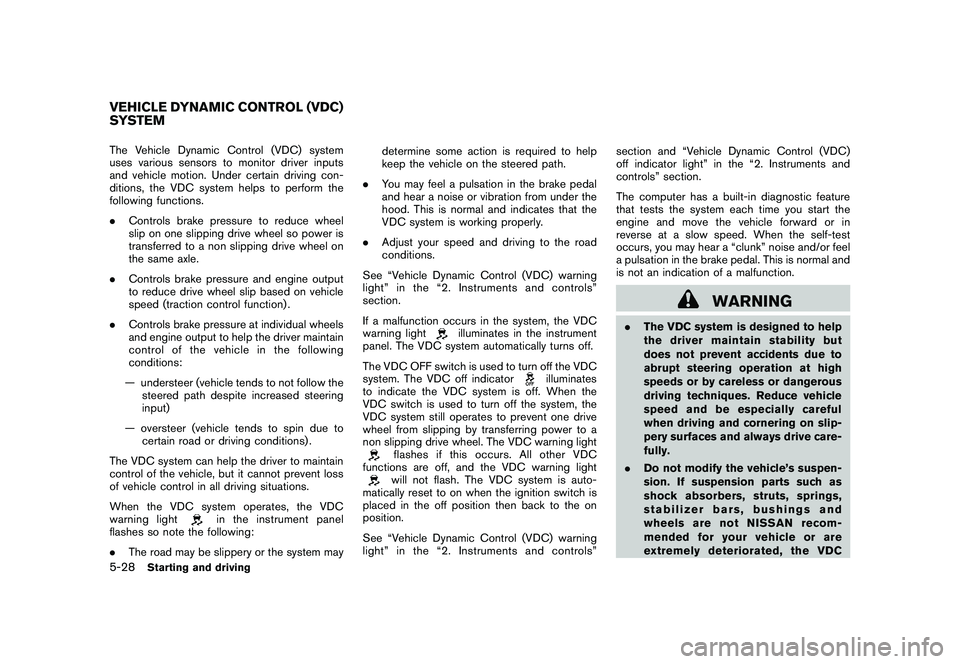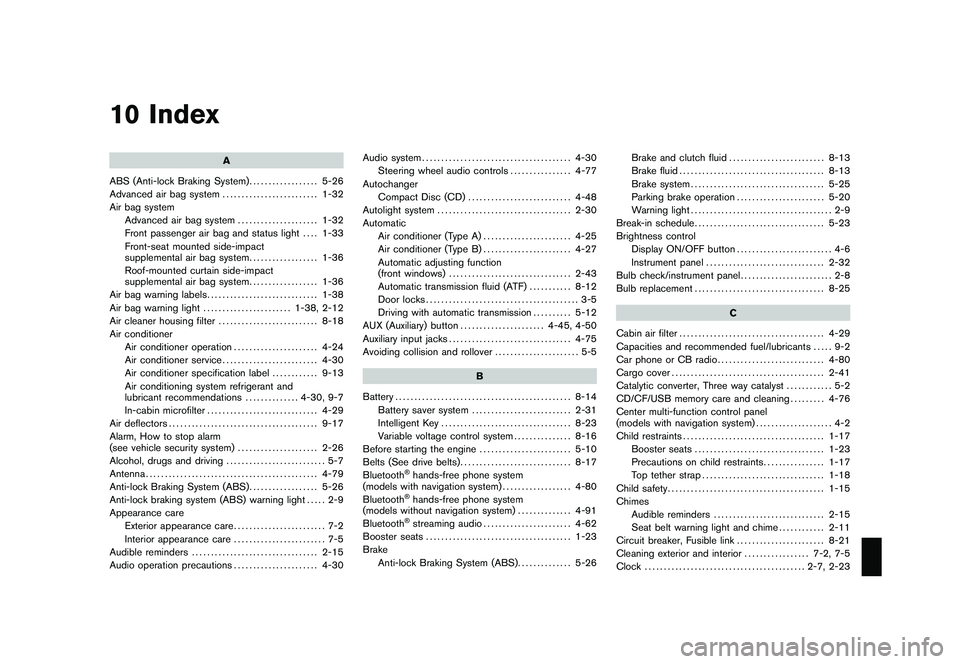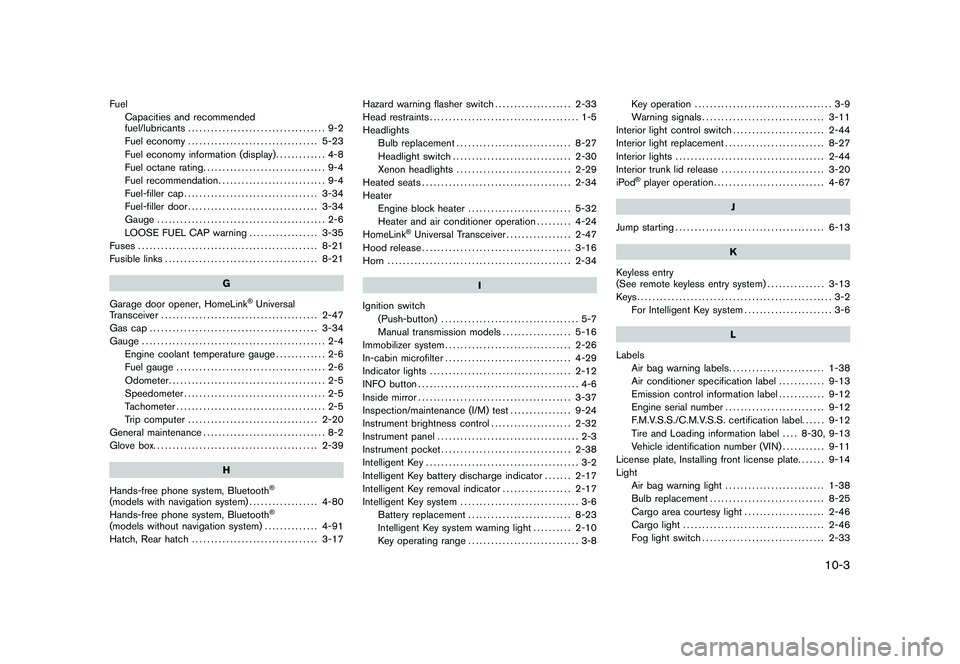2011 NISSAN 370Z ROADSTER instrument panel
[x] Cancel search: instrument panelPage 290 of 419

Black plate (286,1)
Model "Z34-D" EDITED: 2010/ 7/ 27
SSD0825
OPERATING RANGE FOR ENGINE
START FUNCTIONThe Intelligent Key can only be used for starting
the engine when the Intelligent Key is within the
specified operating range
*1.
When the Intelligent Key battery is almost
discharged or strong radio waves are present
near the operating location, the Intelligent Key
system’s operating range becomes narrower
and may not function properly.
If the Intelligent Key is within the operating
range, it is possible for anyone, even someone
who does not carry the Intelligent Key, to push
the ignition switch to start the engine. .
The cargo/trunk room area is not included in
the operating range but the Intelligent Key
may function.
. If the Intelligent Key is placed on the
instrument panel, rear parcel shelf, inside
the glove box or door pocket, the Intelligent
Key may not function.
. If the Intelligent Key is placed near the door
or window outside the vehicle, the Intelligent
Key may function.
SSD1021
PUSH-BUTTON IGNITION SWITCH
OPERATIONWhen the ignition switch is pushed without
depressing the brake pedal (automatic transmis-
sion model) or the clutch pedal (manual
transmission model) , the ignition switch position
will change as follows:
.Push center once to change to ACC.
. Push center two times to change to ON.
. Push center three times to change to OFF.
(No position illuminates.)
. Push center four times to return to ACC.
. Open or close any door to return to LOCK
5-8
Starting and driving
Page 309 of 419

Black plate (305,1)
Model "Z34-D" EDITED: 2010/ 7/ 27
distances may also be longer on
rough, gravel or snow covered
roads, or if you are using tire chains.
Alwaysmaintainasafedistance
from the vehicle in front of you.
Ultimately, the driver is responsible
for safety.
. Tire type and condition may also
affect braking effectiveness.
— When replacing tires, install the
specified size of tires on all four
wheels.
— When installing a spare tire, make sure that it is the proper
size and type as specified on the
Tire and Loading Information
label. See “TIRE AND LOADING
INFORMATION LABEL” in the “9.
Technical and consumer infor-
mation” section of this manual.
— For detailed information, see “WHEELS AND TIRES” in the
“8. Maintenance and do-it-your-
self” section of this manual.
The Anti-lock Braking System (ABS) controls
the brakes so the wheels do not lock during hard
braking or when braking on slippery surfaces.
The system detects the rotation speed at each wheel and varies the brake fluid pressure to
prevent each wheel from locking and sliding. By
preventing each wheel from locking, the system
helps the driver maintain steering control and
helps to minimize swerving and spinning on
slippery surfaces.
Using the systemDepress the brake pedal and hold it down.
Depress the brake pedal with firm steady
pressure, but do not pump the brakes. The
ABS will operate to prevent the wheels from
locking up. Steer the vehicle to avoid obstacles.
WARNING
Do not pump the brake pedal. Doing so
may result in increased stopping dis-
tances.Self-test featureThe ABS includes electronic sensors, electric
pumps, hydraulic solenoids and a computer. The
computer has a built-in diagnostic feature that
tests the system each time you start the engine
and move the vehicle at a low speed in forward
or reverse. When the self-test occurs, you may
hear a “clunk” noise and/or feel a pulsation in the
brake pedal. This is normal and does not
indicate a malfunction. If the computer senses
a malfunction, it switches the ABS off and
illuminates the ABS warning light on theinstrument panel. The brake system then oper-
ates normally, but without anti-lock assistance.
If the ABS warning light illuminates during the
self-test or while driving, have the vehicle
checked by a NISSAN dealer.
Normal operationThe ABS operates at speeds above 3 to 6 MPH
(5 to 10 km/h) .
When the ABS senses that one or more wheels
are close to locking up, the actuator rapidly
applies and releases hydraulic pressure. This
action is similar to pumping the brakes very
quickly. You may feel a pulsation in the brake
pedal and hear a noise from under the hood or
feel a vibration from the actuator when it is
operating. This is normal and indicates that the
ABS is operating properly. However, the pulsa-
tion may indicate that road conditions are
hazardous and extra care is required while
driving.
Starting and driving
5-27
Page 310 of 419

Black plate (306,1)
Model "Z34-D" EDITED: 2010/ 7/ 27
The Vehicle Dynamic Control (VDC) system
uses various sensors to monitor driver inputs
and vehicle motion. Under certain driving con-
ditions, the VDC system helps to perform the
following functions.
.Controls brake pressure to reduce wheel
slip on one slipping drive wheel so power is
transferred to a non slipping drive wheel on
the same axle.
. Controls brake pressure and engine output
to reduce drive wheel slip based on vehicle
speed (traction control function) .
. Controls brake pressure at individual wheels
and engine output to help the driver maintain
control of the vehicle in the following
conditions:
— understeer (vehicle tends to not follow the steered path despite increased steering
input)
— oversteer (vehicle tends to spin due to certain road or driving conditions) .
The VDC system can help the driver to maintain
control of the vehicle, but it cannot prevent loss
of vehicle control in all driving situations.
When the VDC system operates, the VDC
warning light
in the instrument panel
flashes so note the following:
. The road may be slippery or the system may determine some action is required to help
keep the vehicle on the steered path.
. You may feel a pulsation in the brake pedal
and hear a noise or vibration from under the
hood. This is normal and indicates that the
VDC system is working properly.
. Adjust your speed and driving to the road
conditions.
See “Vehicle Dynamic Control (VDC) warning
light” in the “2. Instruments and controls”
section.
If a malfunction occurs in the system, the VDC
warning light
illuminates in the instrument
panel. The VDC system automatically turns off.
The VDC OFF switch is used to turn off the VDC
system. The VDC off indicator
illuminates
to indicate the VDC system is off. When the
VDC switch is used to turn off the system, the
VDC system still operates to prevent one drive
wheel from slipping by transferring power to a
non slipping drive wheel. The VDC warning light
flashes if this occurs. All other VDC
functions are off, and the VDC warning lightwill not flash. The VDC system is auto-
matically reset to on when the ignition switch is
placed in the off position then back to the on
position.
See “Vehicle Dynamic Control (VDC) warning
light” in the “2. Instruments and controls” section and “Vehicle Dynamic Control (VDC)
off indicator light” in the “2. Instruments and
controls” section.
The computer has a built-in diagnostic feature
that tests the system each time you start the
engine and move the vehicle forward or in
reverse at a slow speed. When the self-test
occurs, you may hear a “clunk” noise and/or feel
a pulsation in the brake pedal. This is normal and
is not an indication of a malfunction.
WARNING
.
The VDC system is designed to help
the driver maintain stability but
does not prevent accidents due to
abrupt steering operation at high
speeds or by careless or dangerous
driving techniques. Reduce vehicle
speed and be especially careful
when driving and cornering on slip-
pery surfaces and always drive care-
fully.
. Do not modify the vehicle’s suspen-
sion. If suspension parts such as
shock absorbers, struts, springs,
stabilizer bars, bushings and
wheels are not NISSAN recom-
mended for your vehicle or are
extremely deteriorated, the VDC
VEHICLE DYNAMIC CONTROL (VDC)
SYSTEM5-28
Starting and driving
Page 411 of 419

Black plate (1,1)
10 Index
A
ABS (Anti-lock Braking System) .................. 5-26
Advanced air bag system ......................... 1-32
Air bag system Advanced air bag system ..................... 1-32
Front passenger air bag and status light .... 1-33
Front-seat mounted side-impact
supplemental air bag system .................. 1-36
Roof-mounted curtain side-impact
supplemental air bag system .................. 1-36
Air bag warning labels ............................. 1-38
Air bag warning light ....................... 1-38, 2-12
Air cleaner housing filter .......................... 8-18
Air conditioner Air conditioner operation ...................... 4-24
Air conditioner service ......................... 4-30
Air conditioner specification label ............ 9-13
Air conditioning system refrigerant and
lubricant recommendations .............. 4-30, 9-7
In-cabin microfilter ............................. 4-29
Air deflectors ....................................... 9-17
Alarm, How to stop alarm
(see vehicle security system) ..................... 2-26
Alcohol, drugs and driving .......................... 5-7
Antenna ............................................. 4-79
Anti-lock Braking System (ABS) .................. 5-26
Anti-lock braking system (ABS) warning light ..... 2-9
Appearance care Exterior appearance care ........................ 7-2
Interior appearance care ........................ 7-5
Audible reminders ................................. 2-15
Audio operation precautions ...................... 4-30 Audio system
....................................... 4-30
Steering wheel audio controls ................ 4-77
Autochanger Compact Disc (CD) ........................... 4-48
Autolight system ................................... 2-30
Automatic Air conditioner (Type A) ....................... 4-25
Air conditioner (Type B) ....................... 4-27
Automatic adjusting function
(front windows) ................................ 2-43
Automatic transmission fluid (ATF) ........... 8-12
Door locks ........................................ 3-5
Driving with automatic transmission .......... 5-12
AUX (Auxiliary) button ...................... 4-45, 4-50
Auxiliary input jacks ................................ 4-75
Avoiding collision and rollover ...................... 5-5
B
Battery .............................................. 8-14
Battery saver system .......................... 2-31
Intelligent Key .................................. 8-23
Variable voltage control system ............... 8-16
Before starting the engine ........................ 5-10
Belts (See drive belts) ............................. 8-17
Bluetooth
®hands-free phone system
(models with navigation system) .................. 4-80
Bluetooth®hands-free phone system
(models without navigation system) .............. 4-91
Bluetooth®streaming audio ....................... 4-62
Booster seats ...................................... 1-23
Brake Anti-lock Braking System (ABS) .............. 5-26Brake and clutch fluid
......................... 8-13
Brake fluid ...................................... 8-13
Brake system ................................... 5-25
Parking brake operation ....................... 5-20
Warning light ..................................... 2-9
Break-in schedule .................................. 5-23
Brightness control Display ON/OFF button ......................... 4-6
Instrument panel ............................... 2-32
Bulb check/instrument panel ........................ 2-8
Bulb replacement .................................. 8-25
C
Cabin air filter ...................................... 4-29
Capacities and recommended fuel/lubricants ..... 9-2
Car phone or CB radio ............................ 4-80
Cargo cover ........................................ 2-41
Catalytic converter, Three way catalyst ............ 5-2
CD/CF/USB memory care and cleaning ......... 4-76
Center multi-function control panel
(models with navigation system) .................... 4-2
Child restraints ..................................... 1-17
Booster seats .................................. 1-23
Precautions on child restraints ................ 1-17
Top tether strap ................................ 1-18
Child safety ......................................... 1-15
Chimes Audible reminders ............................. 2-15
Seat belt warning light and chime ............ 2-11
Circuit breaker, Fusible link ....................... 8-21
Cleaning exterior and interior ................. 7-2, 7-5
Clock .......................................... 2-7, 2-23
Model "Z34-D" EDITED: 2010/ 7/ 28
Page 413 of 419

Black plate (3,1)
FuelCapacities and recommended
fuel/lubricants .................................... 9-2
Fuel economy .................................. 5-23
Fuel economy information (display) ............. 4-8
Fuel octane rating ................................ 9-4
Fuel recommendation ............................ 9-4
Fuel-filler cap ................................... 3-34
Fuel-filler door .................................. 3-34
Gauge ............................................ 2-6
LOOSE FUEL CAP warning .................. 3-35
Fuses ............................................... 8-21
Fusible links ........................................ 8-21
G
Garage door opener, HomeLink
®Universal
Transceiver ......................................... 2-47
Gas cap ............................................ 3-34
Gauge ................................................ 2-4
Engine coolant temperature gauge ............. 2-6
Fuel gauge ....................................... 2-6
Odometer ......................................... 2-5
Speedometer ..................................... 2-5
Tachometer ....................................... 2-5
Trip computer .................................. 2-20
General maintenance ................................ 8-2
Glove box. .......................................... 2-39
H
Hands-free phone system, Bluetooth®
(models with navigation system) .................. 4-80
Hands-free phone system, Bluetooth
®
(models without navigation system) .............. 4-91
Hatch, Rear hatch ................................. 3-17 Hazard warning flasher switch
.................... 2-33
Head restraints ....................................... 1-5
Headlights Bulb replacement .............................. 8-27
Headlight switch ............................... 2-30
Xenon headlights .............................. 2-29
Heated seats ....................................... 2-34
Heater Engine block heater ........................... 5-32
Heater and air conditioner operation ......... 4-24
HomeLink
®Universal Transceiver ................. 2-47
Hood release ....................................... 3-16
Horn ................................................ 2-34
I
Ignition switch (Push-button) .................................... 5-7
Manual transmission models .................. 5-16
Immobilizer system ................................. 2-26
In-cabin microfilter ................................. 4-29
Indicator lights ..................................... 2-12
INFO button .......................................... 4-6
Inside mirror ........................................ 3-37
Inspection/maintenance (I/M) test ................ 9-24
Instrument brightness control ..................... 2-32
Instrument panel ..................................... 2-3
Instrument pocket .................................. 2-38
Intelligent Key ........................................ 3-2
Intelligent Key battery discharge indicator ....... 2-17
Intelligent Key removal indicator .................. 2-17
Intelligent Key system ............................... 3-6
Battery replacement ........................... 8-23
Intelligent Key system warning light .......... 2-10
Key operating range ............................. 3-8 Key operation
.................................... 3-9
Warning signals ................................ 3-11
Interior light control switch ........................ 2-44
Interior light replacement .......................... 8-27
Interior lights ....................................... 2-44
Interior trunk lid release ........................... 3-20
iPod
®player operation ............................. 4-67
J
Jump starting ....................................... 6-13
K
Keyless entry
(See remote keyless entry system) ............... 3-13
Keys................................................... 3-2 For Intelligent Key system ....................... 3-6
L
Labels Air bag warning labels ......................... 1-38
Air conditioner specification label ............ 9-13
Emission control information label ............ 9-12
Engine serial number .......................... 9-12
F.M.V.S.S./C.M.V.S.S. certification label. ..... 9-12
Tire and Loading information label .... 8-30, 9-13
Vehicle identification number (VIN) ........... 9-11
License plate, Installing front license plate. ...... 9-14
Light Air bag warning light .......................... 1-38
Bulb replacement .............................. 8-25
Cargo area courtesy light ..................... 2-46
Cargo light ..................................... 2-46
Fog light switch ................................ 2-33
10-3
Model "Z34-D" EDITED: 2010/ 7/ 28